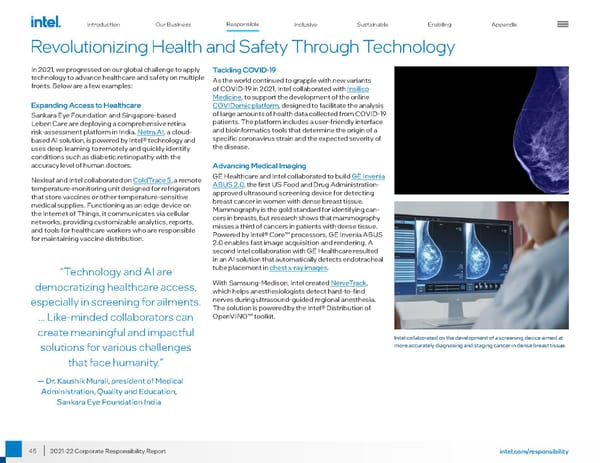45 2021-22 Corporate Responsibility Report Revolutionizing Health and Safety Through Technology In 2021, we progressed on our global challenge to apply technology to advance healthcare and safety on multiple fronts. Below are a few examples: Expanding Access to Healthcare Sankara Eye Foundation and Singapore-based Leben Care are deploying a comprehensive retina risk-assessment platform in India. Netra.AI , a cloud- based AI solution, is powered by Intel® technology and uses deep learning to remotely and quickly identify conditions such as diabetic retinopathy with the accuracy level of human doctors. Nexleaf and Intel collaborated on ColdTrace 5 , a remote temperature-monitoring unit designed for refrigerators that store vaccines or other temperature-sensitive medical supplies. Functioning as an edge device on the Internet of Things, it communicates via cellular networks, providing customizable analytics, reports, and tools for healthcare workers who are responsible for maintaining vaccine distribution. “Technology and AI are democratizing healthcare access, especially in screening for ailments. ... Like-minded collaborators can create meaningful and impactful solutions for various challenges that face humanity.” — Dr. Kaushik Murali, president of Medical Administration, Quality and Education, Sankara Eye Foundation India Tackling COVID-19 As the world continued to grapple with new variants of COVID-19 in 2021, Intel collaborated with Insilico Medicine , to support the development of the online COVIDomic platform , designed to facilitate the analysis of large amounts of health data collected from COVID-19 patients. The platform includes a user-friendly interface and bioinformatics tools that determine the origin of a specific coronavirus strain and the expected severity of the disease. Advancing Medical Imaging GE Healthcare and Intel collaborated to build GE Invenia ABUS 2.0 , the first US Food and Drug Administration- approved ultrasound screening device for detecting breast cancer in women with dense breast tissue. Mammography is the gold standard for identifying can - cers in breasts, but research shows that mammography misses a third of cancers in patients with dense tissue. Powered by Intel® Core™ processors, GE Invenia ABUS 2.0 enables fast image acquisition and rendering. A second Intel collaboration with GE Healthcare resulted in an AI solution that automatically detects endotracheal tube placement in chest x-ray images . With Samsung-Medison, Intel created NerveTrack , which helps anesthesiologists detect hard-to-find nerves during ultrasound-guided regional anesthesia. The solution is powered by the Intel® Distribution of OpenVINO™ toolkit. Intel collaborated on the development of a screening device aimed at more accurately diagnosing and staging cancer in dense breast tissue. Introduction Our Business Inclusive Sustainable Enabling Appendix Responsible intel.com/responsibility
 Intel Corporate Responsibility Report Page 44 Page 46
Intel Corporate Responsibility Report Page 44 Page 46